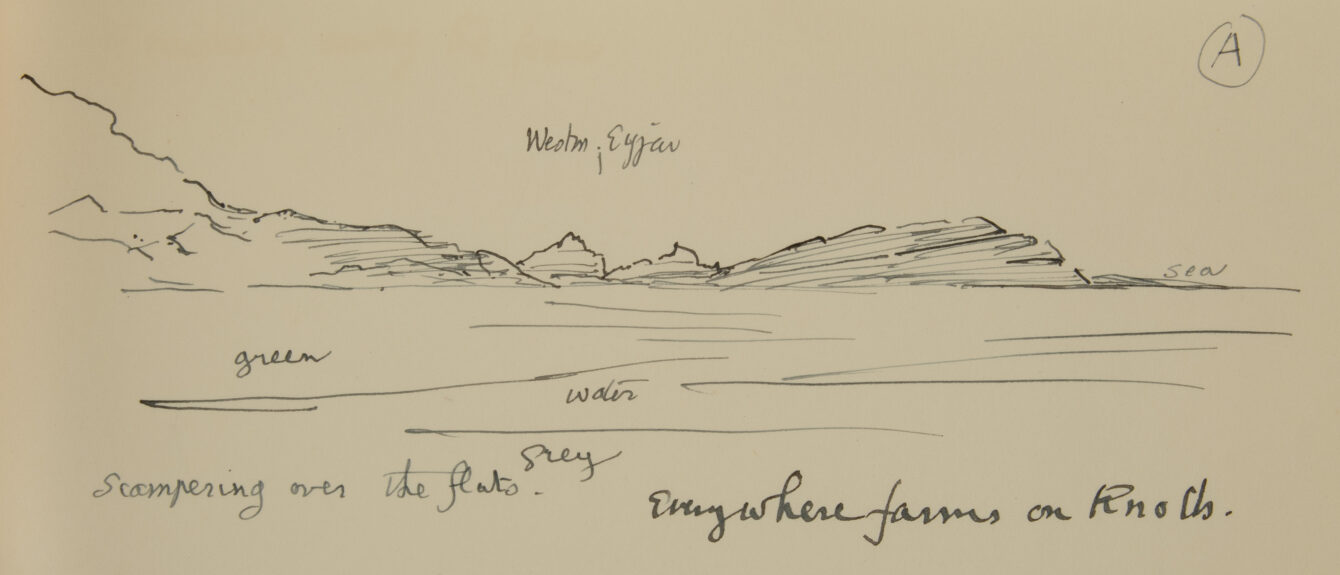Kelmscott Manor announces its new exhibition: ‘Mountains and plains and adventure’ William & May Morris and Iceland

A revelatory new exhibition, ‘Mountains and plains and adventure’: William & May Morris and Iceland, will open at Kelmscott Manor on 6 June, timed to coincide with the centenary of May Morris’s first trip to Iceland.
Visitors to Kelmscott Manor can still experience the spirit of Iceland, most dramatically when they encounter the topiary Fafnir yew hedge, originally cut by William Morris (1834–1896). Morris was one of the Victorian era’s great polymaths – writer, designer, conservationist and social thinker, antiquary and scholar of Icelandic.
Morris’s daughter May (1862–1938), also a designer, acknowledged expert on historic embroidery and with an interest in material culture akin to her father’s, knew Iceland from girlhood through his abiding enthusiasm for its literature and culture. Both had a lengthy and meaningful relationship with the country and were warmly welcomed by Icelanders. He visited twice (1871 and 1873); she three times over half a century later (1924, 1926 and 1931), with the life-companion of her later years, Mary Lobb, as her fellow-traveller.
Morris earned the Icelanders’ lasting affection and gratitude for his cultural and financial contributions to Icelandic society. May Morris was awarded the country’s highest honour, the Order of the Falcon, in 1930. Today, William Morris is still held in high regard in Iceland but May is virtually unknown. Using as its basis the previously unknown diaries she wrote during her Icelandic travels (which were acquired by the Society of Antiquaries of London for Kelmscott Manor in 2018), this exhibition is the first to explore her relationship with Iceland. For the first time May’s Icelandic adventures can be examined comparatively with her father’s better-known experiences and impressions; her observations highlight what had remained constant and what had changed in the intervening years.
Looking at themes including Motivations & Preparations, Hospitality & Friendships, Reading Saga Landscapes, Social & Technological Change, and Recognition & Legacy, the exhibition will draw on the Society of Antiquaries’ own collections at Burlington House and Kelmscott Manor, and include loans from the British Library, William Morris Gallery and Haslemere Educational Museum. Exhibits will include:
– examples both of May Morris’s travel diaries, and the drawings, photographs and ephemera they contain
– artefacts brought back from Iceland by both William and May Morris, including intricately carved items representing the traditional way of life in Iceland such as bed-boards, drinking horn, and hand-woven textiles
– a first edition of the GuðbrandsbiblÍa Bible (1584)
– examples of William Morris’s translations of sagas, calligraphic manuscripts, poetry responding to Iceland, including Kelmscott Press editions
The exhibition is co-curated by Dr Kathy Haslam (Curator, Kelmscott Manor) and Dr Emily Lethbridge (Senior Research Lecturer at the Árni Magnússon Institute for Icelandic Studies, Reykjavík, Iceland).
Dr Kathy Haslam, Curator of Kelmscott Manor, says:
‘We are thrilled at this opportunity to explore May’s passion for both travel and Iceland through her own wonderfully vivid and enlightening words, and to contribute through the exhibition and its catalogue to understanding more deeply the Morris family’s relationship with Iceland.’
Dr Emily Lethbridge says:
‘This exhibition represents an exciting and important milestone, most immediately in the world of Morris studies but also more widely in other areas of cultural history – including women’s travel- writing, and cross-cultural exchange and influence between Iceland and Great Britain in the 19th and 20th centuries.’
ENDS
Notes for Editors
The Society of Antiquaries of London
The Society of Antiquaries of London is Britain’s oldest learned society concerned with the study of the material remains of the past. Founded in 1707, our Royal Charter of 1751 defines our objectives as ‘the encouragement, advancement and furtherance of the study and knowledge of antiquities and history of this and other countries’. We deliver our charitable objectives through activities at two sites – Burlington House, London and Kelmscott Manor, Oxfordshire. Kelmscott Manor is an internationally important collection of C17-C19 century listed buildings, furniture, pictures, textiles and objects created by and associated with William Morris (1834-1896), his family and wider circle. For more information visit: sal.org.uk
Kelmscott Manor Information
Kelmscott Manor was the iconic country home of William Morris; poet, designer, craftsman, socialist and founding father of the Arts and Crafts movement. This Grade I listed house was loved by Morris as an example of traditional craftsmanship in harmony with the nearby village and surrounding landscape, towards the very upper reaches of the Thames.
Today, visitors will find an outstanding collection. The Manor has so many intriguing stories to tell; its collections span over 300 years and reflect the lives, ideas, and creative legacy of those who lived and stayed there.
Kelmscott Manor is open to the public from 4 April – 26 October 2024.
Opening times: Thursday, Friday & Saturday – 10.30am to 5pm, last entry to Manor house 4pm. Pre-booking online is advisable, bookings are now being taken.
Admission costs: Adults: £15, concessions (students and children 5–16) £9.50, family (2 adults & 2 children) £35.00. Pay once and return for free all year with our Annual Pass (T&Cs apply).
A ticket is required for the house, entry to the grounds is free.
Facilities: Toilets, licensed tearoom, gift shop, Learning Barn with family activities. Accessibility: The Manor house has step free access to the ground floor rooms only, all other buildings have step free access. Accessible toilet available.
Kelmscott Manor Kelmscott Lechlade
GL7 3HJ 01367 252486
admin@kelmscottmanor.org.uk kelmscottmanor.org.uk
Press Enquiries
Amanda Stinton, Business Development Manager, amanda.stinton@kelmscottmanor.org.uk.



